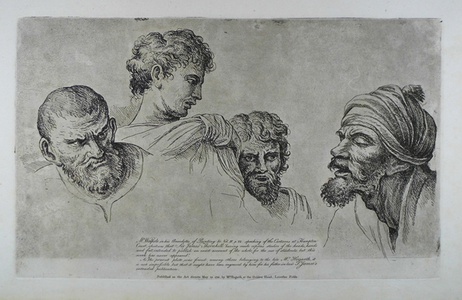| Method | Etching and aquatint |
| Artist | William Hogarth |
| Published | Published as the Act directs May 14. 1781, by Mrs. Hogarth, at the Golden Head, Leicester Fields. [J & J Boydell c.1795] |
| Dimensions | Image & Plate 217 x 355 mm, Sheet 275 x 435 mm |
| Notes |
A study of four heads after Raphael, which was discovered by Mrs Hogarth amongst her husband's papers after his death. Her account of the discovery and its attribution is provided in a lengthy inscription below, which reads: 'Mr. Walpole in his Anecdotes of Painting &c. Vol. IV. p. 22. speaking of the Cartoons at Hampton Court, observes that Sir James Thornhill "having made copious studies of the heads, hands and feet, intended to publish an exact account of the whole, for the use of students: but this work has never appeared." As the present plate was found among others belonging to the late Mr. Hogarth, it is not impossible but that it might have been engraved by him for his father-in-law Sr. James's intended publication.' The heads themselves are from Raphael's Paul and the Blind Magician Elymas before Sergius Paulus, which is now in the collections of the Victoria & Albert Museum. Paulson suggests that although the heads are not done in the style of Hogarth, they could well have been executed to show his skill and academic knowledge of the Old Master, or simply as a veristic copy. Alternatively, Paulson also comments that the plate may have been etched by Thornhill himself, and kept by Hogarth for sentimental reasons. William Hogarth (1697 - 1764) was born in London, the son of an unsuccessful schoolmaster and writer from Westmoreland. After apprenticeship to a goldsmith, he began to produce his own engraved designs in about 1710. He later took up oil painting, starting with small portrait groups called conversation pieces. He went on to create a series of paintings satirising contemporary customs, but based on earlier Italian prints, of which the first was The Harlot's Progress (1731), and perhaps the most famous The Rake's Progress. His engravings were so plagiarised that he lobbied for the Copyright Act of 1735, commonly referred to as 'Hogarth's Act,' as a protection for writers and artists. During the 1730s Hogarth also developed into an original painter of life-sized portraits, and created the first of several history paintings in the grand manner. Paulson 264 ii/ii Condition: Excellent impression with wide margins. Tear to bottom margin, not affecting image or plate. Light water stain to bottom of sheet into plate. |
| Framing | unmounted |
| Price | £175.00 |
| Stock ID | 38143 |

